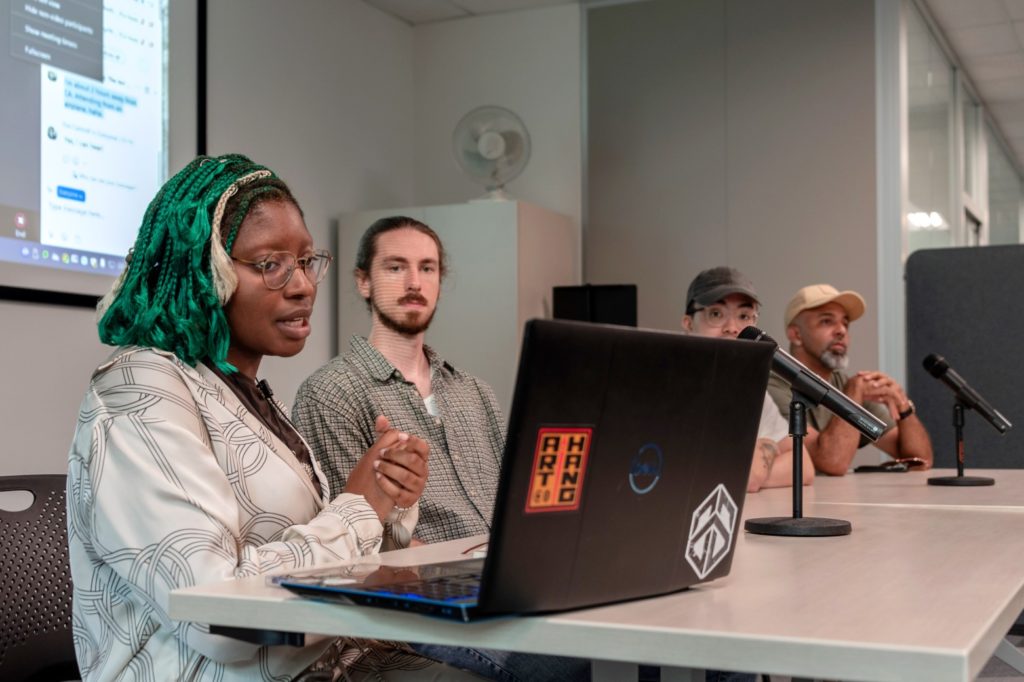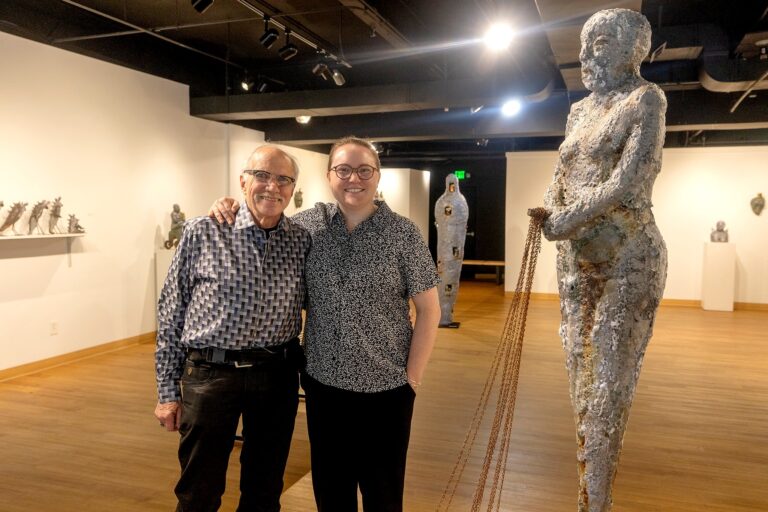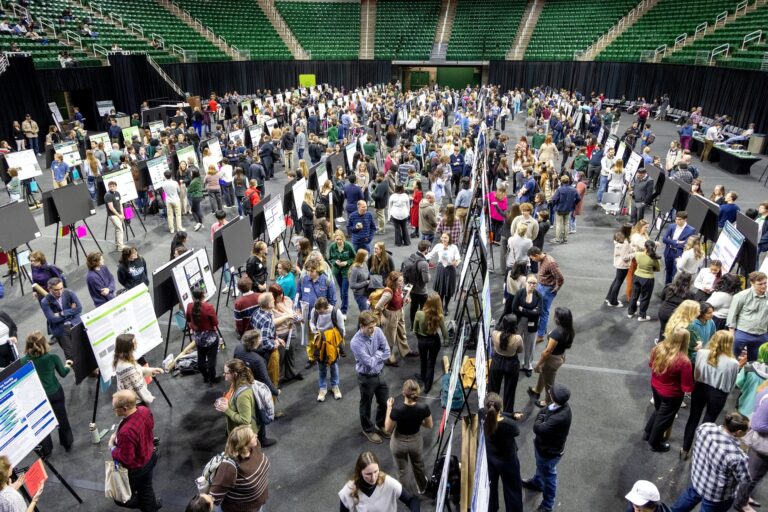Morgan Reneé Hill, a Master of Fine Arts candidate in the Department of Art, Art History, and Design at Michigan State University, has created an innovative art display that utilizes the 360 Visualization Room in the MSU Libraries Digital Scholarship Lab to offer a unique immersive experience into the art of Breaking (breakdancing).
With support from the Graduate Arts Fellowship offered through Digital Humanities at MSU, Hill combined visual art, dance, and digital technology to create Rituals In Communities: The Art of Breaking, which showcases the powerful movements of Breaking accompanied by surround sound and animation.

This multilayered art installation is a compelling exploration of community, culture, and communication where Hill examines the ritualistic nature of community bonding through non-verbal communication.
For the project, Hill collaborated with All of the Above (AOTA) Hip Hop Academy in Lansing, Michigan, and invited AOTA Breakers to perform on Yupo paper, which is a non-absorbent opaque paper in which the oils from a person’s touch sit on top the paper and over continued contact build upon each other.
As the AOTA Breakers danced on the Yupo paper, their footprints, handprints, and other physical traces were left behind, creating a visual record of their collective activity. Hill later enhanced these marks with ink, transforming the physical remnants of the dance into a complex, abstract composition that reflects the energy, rhythm, and spirit of the performance. The sound of the dancers’ movements and the music’s cadence also were recorded to accompany the visual language.

“This project acknowledges and sheds light on the key physical actions of dance that Black individuals do together in a private community,” Hill said. “By memorializing this tradition in my community, I am able to create a digital heritage for people to look back upon.”
Hill’s evolution as an artist has been greatly influenced by a simple, yet profound question posed during a committee meeting in her graduate program at MSU: “You’re making work about the community, but where is the community in your work?”
“I realized instead of making work about the people, the people should be the subject…Now I’m inviting people into the work physically, and their marks are like my brush strokes that directly coincide with the imagery of the work.”
“I realized instead of making work about the people, the people should be the subject. The people can directly be in contact with the work, so it becomes more of a social practice, instead of a studio practice,” Hill said. “Now I’m inviting people into the work physically, and their marks are like my brush strokes that directly coincide with the imagery of the work. I realized the ability I had to be able to conduct these spaces. From that moment on, the pieces really expanded into these profound paintings and drawings.”
As this evolution took place, Hill began to see the potential for her work to bridge different disciplines and perspectives, particularly within communities often underrepresented in the arts. She became increasingly interested in the small, everyday rituals that define communal life – those non-verbal exchanges and moments of contact that are often overlooked but play a crucial role in bonding individuals together. Her focus shifted towards capturing these interactions in a way that not only documents them but also honors and elevates them as a form of cultural expression.

“I can use my platform to make a piece where people do an activity on the paper itself, and then through that, I can display it and the community can then come and view the works themselves,” Hill said. “Every time I’m making a piece, it’s almost like I’m bridging a gap between different perspectives. It became a full circle of me dancing, singing, and writing when I was younger. All that still comes into play with the current work that I’m doing because I can involve people who do those things. It’s a very multidimensional type of process.”
Hill’s growing focus on community also led her to explore the intersection of art and technology. As a 2023-2024 Cultural Heritage Informatics Graduate Fellow, she began integrating digital tools into her practice with the first iteration of the Rituals In Communities series. This integration further evolved into Rituals In Communities: The Art of Breaking where, as a 2024 Graduate Arts Fellow, Hill used both physical and digital mediums to create a multi-sensory experience.

Through the Graduate Arts Fellowship, Hill had the opportunity to utilize and experiment with the digital tools and other resources within the MSU Libraries Digital Scholarship Lab, including the 360 Visualization Room, DSLR cameras, lighting equipment, and the ambisonic microphone that captures sound from all directions. The use of these resources enabled Hill to transform Rituals In Communities: The Art of Breaking into an immersive digital exhibition that engages the visual senses.
“The viewer should feel enveloped by the piece, imitating the feeling of being surrounded in a dance studio with other people,” Hill said. “It’s this entirely immersive project. It activates different senses that you might not always have in a gallery space.”
Rituals In Communities: The Art of Breaking will be discussed and on display during the Artist Workshop: Follow the Flow scheduled for 4:30-6:30 p.m. Friday, Sept. 20, in the 360 Visualization Room of the MSU Libraries Digital Scholarship Lab. The workshop is an interactive movement session with Hill that will focus on how sound and imagery can impact the creativity and freedom in dance. All levels of experience in dance are welcome, and attendees are encouraged to wear comfortable clothing and sneakers.

Hill also held an artist talk on Sept. 5 that explored the collaboration and creative process for Rituals In Communities: The Art of Breaking and the interdisciplinarity approach that defines her art.
Hill’s work with Rituals In Communities: The Art of Breaking represents the beginning of what she envisions as a long-term exploration of community, culture, and digital media. She sees endless possibilities in this interdisciplinary approach, believing that projects like this can continue to grow and evolve for decades.
“I’m hoping for more opportunities like this where I’m able to test out new equipment, new spaces. I like a challenge,” Hill said. “I am the type of person who will continue to take something that is impossible and make it possible in my own kind of way.”


